Sustainable gardens: 10 ideas for an eco-friendly space
Reduce waste and be kinder to the environment with our tips for sustainable gardens – from furniture and paving choices to planting advice
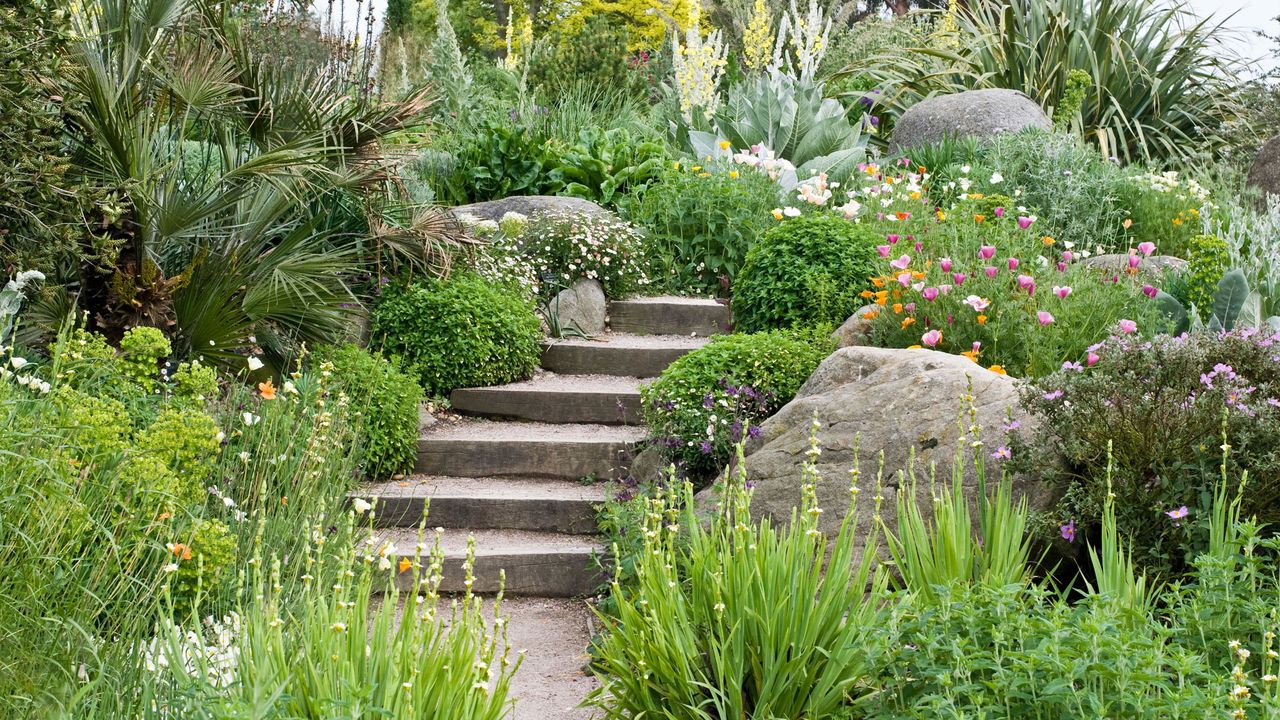

The interest for sustainable gardens is on the rise, which can only be a good thing. Collectively, we are becoming more conscious of our impact on the planet. And, although this awareness relates to our transport, eating, and recycling habits, it can also expand to our outdoor spaces.
Gardens are our way of bringing nature into our home space, to celebrate wildlife and plants, and enjoy the fresh air. It makes sense to ensure that these pockets of greenery are environmentally responsible – helping our planet to thrive rather than hindering it.
It's all about reducing waste and creating a minimal footprint, but as an extra benefit, sustainable gardens are often budget-friendly too. This is due to the emphasis on upcycling and natural methods.
So, how do you start making your garden more sustainable? We've rounded up some of our favorite and easy-to-follow tips and advice to guide you on your way. From gorgeous outdoor furniture made from recycled materials to low-carbon-footprint paving and more, once you've finished reading, you'll be full of inspiration for an eco-friendly plot.
1. Look for recycled planters
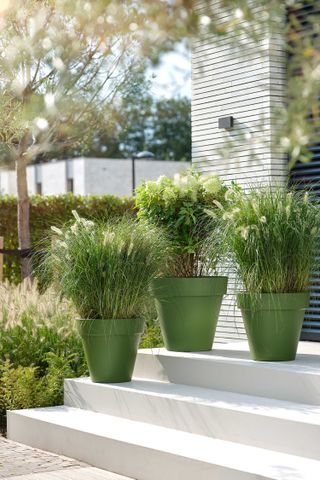
The Pure round grass planters from Elho are perfect for sustainable gardens
Garden planter ideas are a wonderful way to liven up a patio, porch, or balcony. But, when picking your container of choice, it's worth thinking about which eco options are available.
For instance, these planters shown above are made from 100% recycled material from the waste of artificial grass production, which is why they're such a lovely green hue. Planted up with ornamental grasses, they make a striking feature against pale paving.
You could also look for terracotta pots from charity shops, or even upcycle bits and bobs around the house to create unique containers. Washed out tins and old wooden wine boxes make great options. All of these can be given a lick of exterior paint for an extra touch of pizzazz.
2. Try sustainable garden furniture
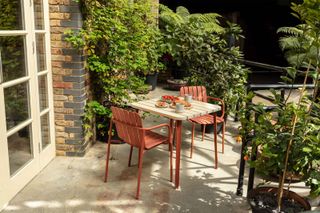
The Latte Chair and Canteen Table are both from Very Good & Proper
Garden furniture ideas allow us to enjoy our outdoor spaces to the maximum, providing a place to sit, eat, socialize, and relax. However, before you splash the cash on a brand new set, check to see how it impacts the planet.
These chairs, shown above, are made using biocomposite technology which combines recycled plastic with hemp fibres to drastically lower the CO2-impact of production. Not only does this approach repurpose a waste stream whilst introducing a renewable, agricultural ingredient into its production, but also the chair can be recycled again. The table top is made from durable Accoya wood, sustainably sourced with FSC® certification. The table legs are made from recycled aluminium.
'We should educate ourselves in understanding the environmental impacts of the products we buy and make informed and balanced decisions,' says Ed Carpenter, CEO of Very Good & Proper.
It's worth thinking about where furniture comes from too, as well as the materials that it's made of. 'Nowadays, many pieces of furniture have been greenwashed,' continues Ed. 'Although they might be made from "eco-friendly" materials, they have been shipped half-way around the world and then back again – which is not sustainable.'
3. Pick sustainable paving for your plot
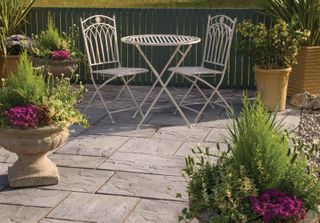
The Ashbourne Eco paving from Bradstone is a fabulous choice for sustainable gardens
Did you know that you can take eco-friendly approaches when selecting your paving? For sustainable gardens, it's a great factor to consider.
This can be from using local stone, which reduces the carbon footprint caused by transportation. Or, if your neighbors have recently completed a building project, see if they have any waste materials which you can reuse, such as red bricks.
You can also look for brands which sell paving produced by sustainable methods. As demonstrated by the chic patio scene above, going eco-friendly doesn't mean you have to sacrifice on style.
Take a look at our eco paving tips for more advice.
4. Opt for eco-friendly dinnerware
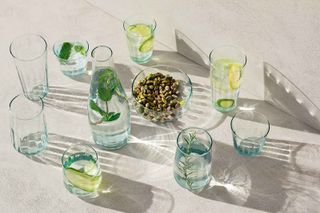
The Mia collection from LSA International is made from recycled glass
As the weather warms, the garden becomes the perfect place to entertain family and friends. If you're trying to be more eco-friendly, why not opt for sustainable tableware for your alfresco lunch party or evening soirée outdoors?
This beautiful set is made by hand from 100% recycled, locally-sourced glass, and looks stunning with its delicate green finish and small air bubbles. It would make a lovely addition to your outdoor dining ideas.
For more casual snacks, or for kids, look for plates and tumblers made from sustainably-grown bamboo, rather than using brightly-colored plastic or disposable paper varieties.
5. Avoid using peat for sustainable gardens
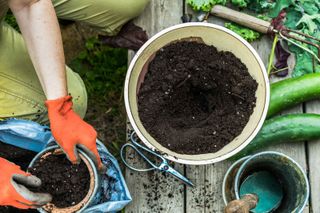
Peat-free is the way forward with sustainable gardens
Peat is made from decayed vegetation from thousands of years ago, and is often known as an alternative, or an addition, to garden compost. However, over recent years gardeners (and in the UK, the government) have become more conscious of the negative consequences that this has on the environment.
In the wild, peat bogs are a haven for wildlife, and mining for the material destroys these natural habitats. Peat bogs also store large amounts of carbon, and damaging them releases a major amount of greenhouse gases. What's more, they are important for soaking up water and reducing floods. Peat also takes a long time to reform, much longer than it takes to mine it – which makes it an unsustainable material to use. So basically, if you're striving for a more sustainable garden, stay away from peat.
Lots of garden centers are adapting to this, too. For instance, Worfield Plants are soon to be introducing a whole range of peat free plants. 'We recognize that it's essential that responsible gardening brands get behind the government targets for reducing the amount of peat we are using,' says Lark Hanham of Worfield Plants.
As well as buying peat-free compost and plants from garden centers, you can also make your own at home. Not only will it save you money, but it's also a good way to make the most of your green waste. Find out how to compost in our guide.
6. Get creative with upcycling
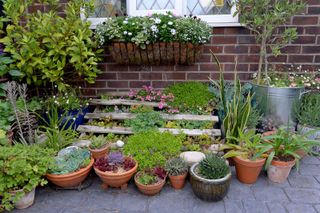
Try upcycling old pallets for sustainable gardens
As we've mentioned, sustainable gardens are all about leaving less of a trace on our planet. So, rather than always buying new and throwing away the old, try to upcycle items where possible.
Pallets, for example, provide a world of creative opportunities. With just a few DIY skills, they can be transformed into planters (like in this scene), fences, or even benches and tables. Take a look at our pallet furniture ideas for inspiration.
Old buckets, containers, even sinks, can be transformed into nifty plant pots for sustainable gardens. Or, if you have a tree cut down in your plot, try using sections of log for stepping stones. Wooden spoons can be used for plant labels in your raised beds, and old jam jars can be filled with tea lights and dotted around your patio scene for an ambience booster. Once you start thinking about all the ways that you can repurpose objects, you'll realize just how many options there are.
7. Save your water
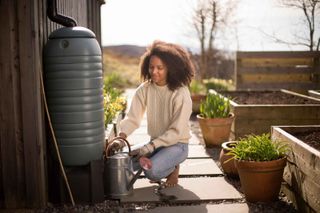
A water butt makes an ecological addition to sustainable gardens
Rather than turning on the tap to fill up your watering can, or blasting your flowerbeds with the hose, invest in a water butt. These features collect rainwater run-off from roofs, which can then be reused around your plot.
This will save on your water bill, helps to reduce flooding, and will ensure that there's a handy supply of water available during dry spells (especially if there's a hosepipe ban). Of course, it also reduces water waste, which is great for sustainable gardens.
Plus, rainwater is much better for plants anyway, as opposed to chemically-treated tap water.
8. Opt for alpines
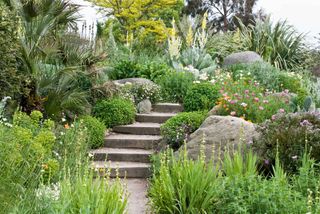
Alpine gardens are less reliant on regular watering
Speaking of water, you could try to reduce the need for it in your plot altogether by choosing your plants carefully.
'As weathers warm and droughts become a regular feature from year-to-year, why not garden with alpines?' says Lark Hanham of Worfield Plants. Not only do they cater for those with minimal space to garden, but they also provide a plethora of interest from their miniature size and have low-demands for water and nutrients, he adds.
Take a look at our small rock garden ideas for lots more inspiration.
9. Go organic
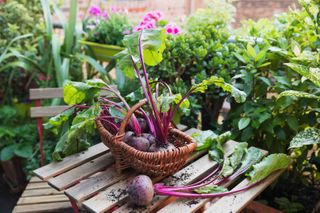
Be more eco-friendly by banishing synthetic chemicals from your plot
Sustainable gardens and organic methods go hand-in-hand. With this approach, synthetic chemical fertilizers, pesticides, and herbicides are off-limits. This is good news for wildlife, your soil, and, if you're growing your own veggies, potentially your health. It also reduces the likelihood of harmful chemicals running into drains, and polluting local rivers and creeks.
There's tons of advice out there to make the switch – our guide to organic gardening is a good place to start.
10. Switch plastic seed trays for more sustainable options
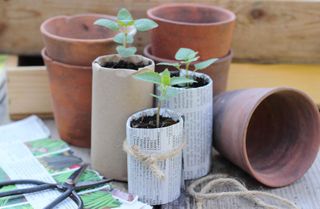
Try growing seedlings in newspaper pots
As a general rule, single-use plastic is always best avoided. In the supermarket this applies to the types of nonrecyclable packaging that goes straight in the bin. In restaurants, think plastic straws. But in the garden, plastic seedling trays and pots are good (or should we say bad?) examples of unnecessary waste.
Instead, opt for solutions which will naturally biodegrade into the earth. The cardboard tube from toilet rolls, or pots made from newspaper are two useful options. You can also try eggshells, egg boxes, or paper coffee cups.
Alternatively, you can find seedling trays made from sustainably-grown bamboo, which, when you're finished with them, will decompose quickly once broken up into soil.
Why is sustainable gardening important?
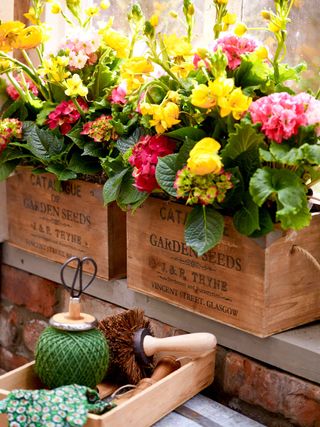
With just a few switches, you can make your garden more sustainable
You've undoubtedly heard it before, but our planet could do with a helping hand right about now. Thanks to years of bad practice, misuse of natural resources, and generation of waste and pollution, the earth is showing some serious signs of deterioration. Resulting issues such as the decline of wildlife and global warming are serious signs, but ones that we can all help to address, even in the comfort of our own homes.
Sustainable gardening is just one way to give back to the earth, use what we have resourcefully, and try to provide a better future, both for us and for generations to come. What's more, nurturing a sustainable garden encourages us to get back in touch with nature and tune in with our environment. All in all, sustainable gardens are good for the soul and the planet, and with just a few switches, simple to achieve.

The garden was always a big part of Holly's life growing up, as was the surrounding New Forest where she lived. Her appreciation for the great outdoors has only grown since then. She's been an allotment keeper, a professional gardener, and a botanical illustrator – plants are her passion.
-
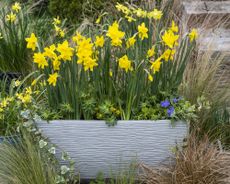 An Update on Gardeningetc
An Update on GardeningetcA word from our publisher
By Beth Murton Published
-
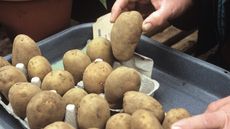 Do you need to chit potatoes? Find out what the experts say
Do you need to chit potatoes? Find out what the experts sayGrow Your Own Learn how to chit potatoes before planting them in the ground and you’ll be on your way to getting an earlier and bigger harvest
By Drew Swainston Published
